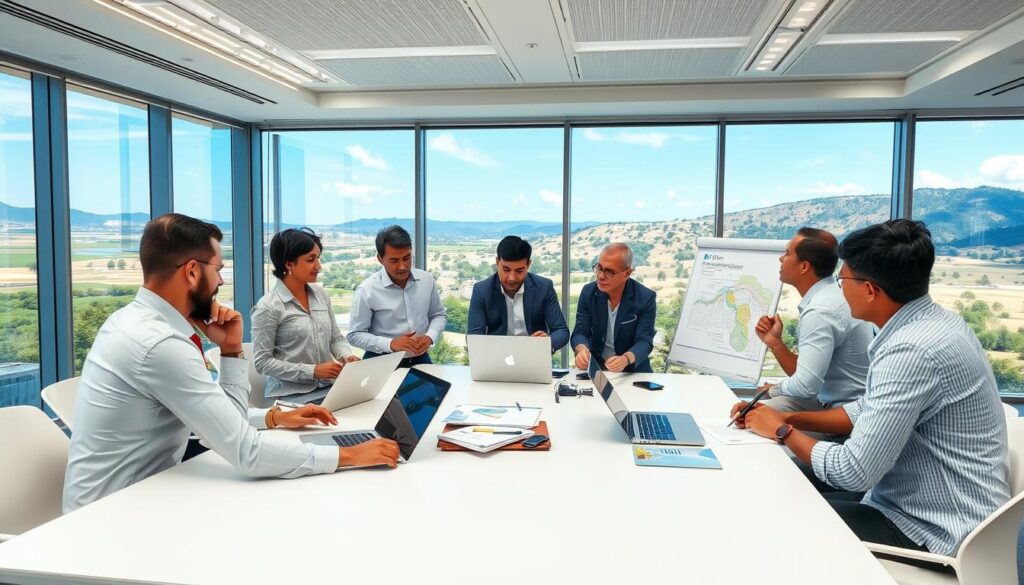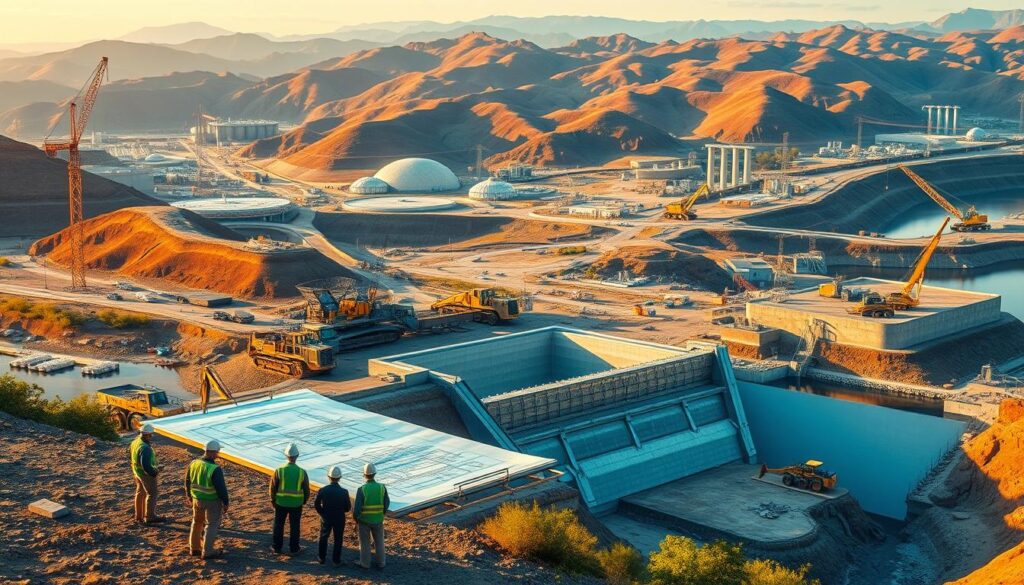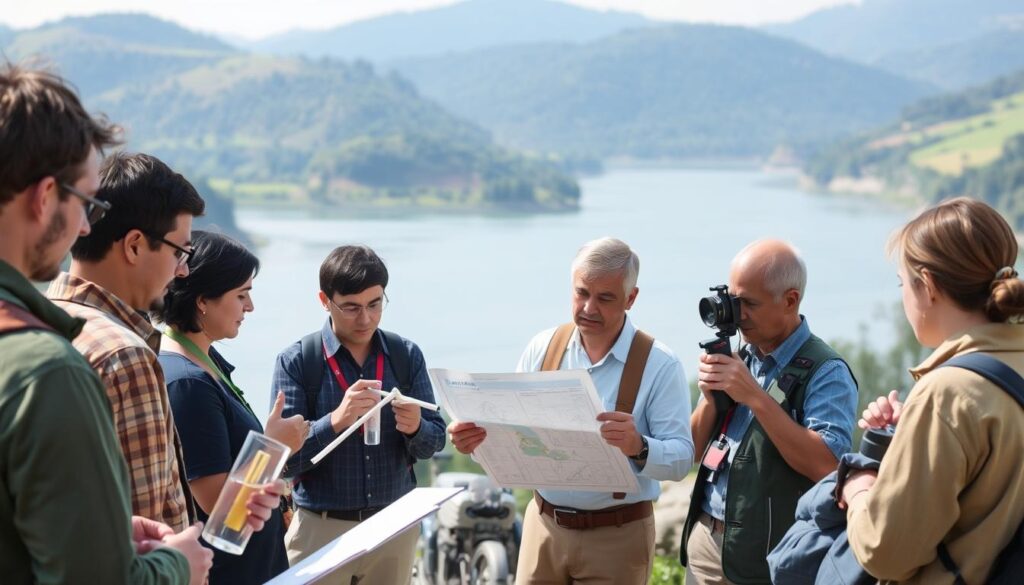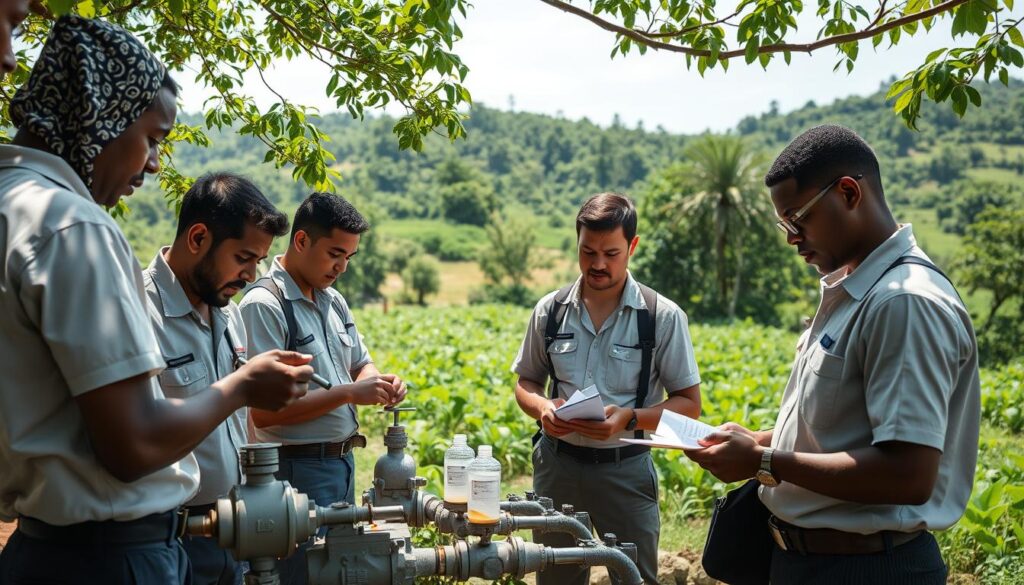Can effective training programs really make a difference in addressing global water challenges? The answer lies in enhancing expertise in sustainable water resource management.
According to the World Health Organization, capacity building is essential for effectively responding to these challenges. As the demand for clean water continues to grow, it is crucial to develop comprehensive training programs in water management.
This article will explore the importance of water engineering capacity building and provide tips on how to master it.
Key Takeaways
- Understanding the importance of capacity building in water resource management
- Identifying effective training programs for water management
- Developing strategies for enhancing water engineering expertise
- Implementing comprehensive training programs
- Achieving sustainable water resource management through capacity building
Understanding Water Engineering Capacity Building
Understanding the nuances of water engineering capacity building is essential for developing effective water infrastructure development projects. Capacity building in this context refers to the process of enhancing the abilities and capacities of individuals, organizations, and institutions involved in water engineering.
Definition and Importance
The Delft Declaration defined capacity building in the water sector as encompassing the creation of an enabling environment, institutional development, and human resources development. This comprehensive approach is crucial for sustainable water management and professional development in water engineering. By focusing on these areas, capacity building initiatives can significantly enhance the overall effectiveness of water engineering projects.
Capacity building is important because it addresses the complex challenges faced by the water sector, including aging infrastructure, water scarcity, and climate change impacts. It ensures that water professionals have the necessary skills and knowledge to design, implement, and manage water infrastructure projects effectively.
Key Components of Capacity Building
The key components of capacity building in water engineering include:
- Creating an enabling environment through policy and regulatory frameworks
- Institutional development, including organizational strengthening and infrastructure development
- Human resources development through training, education, and professional development programs
By focusing on these components, capacity building initiatives can enhance the overall capacity of water engineering professionals and organizations, leading to improved water infrastructure development and management.
Current Challenges in Water Engineering

Water engineering is at a crossroads, grappling with aging infrastructure, water scarcity, and the impacts of climate change. The sector faces significant hurdles that necessitate comprehensive solutions and strategic planning to ensure sustainable water management.
Aging Infrastructure
Aging infrastructure poses a substantial challenge to water engineering. Many water systems in the United States are decades old, requiring infrastructure resilience training to upgrade and maintain them effectively. For instance, a report by the American Society of Civil Engineers highlights the need for significant investment in water infrastructure to address the growing issue of aging pipes and facilities. You can read more about the challenges faced by water infrastructure engineers in the face of climate change on ASCE.
Water Scarcity
Water scarcity is another critical issue affecting water engineering. Effective water project management skills are crucial for developing projects that conserve water and enhance its efficient use. This involves implementing advanced technologies and practices that reduce water waste and promote water recycling. The importance of managing water scarcity is underscored by global initiatives that aim to improve water security, as discussed on World Civil Society.
Climate Change Impacts
Climate change exacerbates both aging infrastructure and water scarcity. Rising temperatures and changing precipitation patterns strain existing water infrastructure, necessitating adaptive measures to ensure resilience. This includes incorporating climate resilience into water project planning and management, which demands advanced water project management skills. By enhancing these skills, water engineers can better mitigate the impacts of climate change on water resources.
Essential Skills for Water Engineers
To excel in their field, water engineers must acquire a combination of technical, managerial, and interpersonal skills. Professional development in water engineering is crucial for staying updated with the latest technologies and methodologies.
Technical Skills
Water engineers require a strong foundation in technical skills, including knowledge of hydrology, hydraulics, and water quality management. They must be proficient in using software tools for modeling and simulating water systems. Advanced technical skills are necessary for designing and implementing effective water management solutions.
Project Management
Effective water project management skills are essential for overseeing projects from conception to completion. This includes planning, budgeting, and coordinating with various stakeholders. Water engineers must be able to manage resources efficiently and mitigate risks to ensure project success.
Communication Skills
Good communication is vital for water engineers to convey their ideas, plans, and findings to stakeholders, including the public, policymakers, and other engineers. Clear and concise communication helps in building trust and ensuring that projects are well-understood and supported by the community.
In conclusion, the role of a water engineer is complex and demands a wide range of skills. By focusing on professional development in water engineering and acquiring water project management skills, water engineers can effectively address the challenges in water management and contribute to sustainable development.
Best Practices in Capacity Building

Enhancing water management through capacity building is a multifaceted approach that involves several key strategies. Effective capacity building is crucial for developing the skills and knowledge necessary to address complex water management challenges.
Training and Development Programs
One of the primary methods of capacity building is through training and development programs. These programs are designed to enhance the technical skills of water professionals, enabling them to effectively manage water resources. Water management training programs can range from workshops on hydrological modeling to courses on sustainable water practices.
Knowledge Sharing Platforms
Another critical aspect of capacity building is the establishment of knowledge sharing platforms. These platforms facilitate the exchange of information and best practices among water professionals, promoting collaboration and innovation. By leveraging these platforms, professionals can stay updated on the latest developments in water management.
Stakeholder Engagement
Stakeholder engagement is also vital for successful capacity building. It involves working closely with local communities, government agencies, and other stakeholders to ensure that capacity building initiatives are tailored to meet specific needs. This collaborative approach helps in building trust and ensures the long-term sustainability of water management projects.
By implementing these best practices, capacity building initiatives can significantly enhance water management capabilities. Capacity building workshops in hydrology, for instance, play a crucial role in improving the understanding and management of hydrological systems.
Role of Government in Capacity Building
The role of government in capacity building is multifaceted, involving policy frameworks, regulations, and funding allocations. Governments are pivotal in shaping the water sector through strategic initiatives that enhance water infrastructure development and water sector capacity enhancement.
Policy Frameworks and Regulations
Governments establish policy frameworks that guide the development and management of water resources. These frameworks are crucial for ensuring that water infrastructure development aligns with national and regional goals. For instance, policies that promote sustainable water management practices can significantly enhance the resilience of water systems.
Regulations play a vital role in enforcing these policies. By setting standards for water quality, usage, and infrastructure maintenance, governments can ensure that water resources are managed effectively. For more information on governance and capacity building, visit Governance and Capacity Building.
- Establishing clear policies and regulations
- Enforcing standards for water quality and infrastructure
- Promoting sustainable water management practices
Funding and Resource Allocation
Adequate funding is essential for the successful implementation of capacity building initiatives in the water sector. Governments allocate resources to various projects, including infrastructure development, training programs, and research initiatives. Effective funding and resource allocation enable the water sector to address current challenges and prepare for future demands.
Some key aspects of government funding include:
- Budget allocation for water infrastructure projects
- Grants and subsidies for research and development
- Partnerships with private entities to leverage additional funding
By prioritizing water sector capacity enhancement and investing in relevant initiatives, governments can ensure a sustainable and resilient water management system.
Collaboration with Educational Institutions

The role of educational institutions in water engineering capacity building cannot be overstated. As the demand for skilled water engineers continues to grow, collaborations between educational institutions and industry stakeholders are becoming increasingly important.
Partnerships for Training
Partnerships between educational institutions and water engineering organizations can lead to the development of tailored training programs. These programs can focus on professional development in water engineering, ensuring that the workforce is equipped with the latest skills and knowledge.
Such collaborations can also facilitate capacity building workshops in hydrology, providing hands-on experience and practical training for students and professionals alike. By working together, educational institutions and industry partners can identify the specific needs of the water engineering sector and develop targeted training initiatives.
Research and Development Initiatives
Educational institutions are not only centers of learning but also hubs for research and innovation. By collaborating with these institutions, water engineering organizations can tap into cutting-edge research and development initiatives.
Research collaborations can lead to the development of new technologies and methodologies in water engineering, enhancing the overall capacity of the sector. For instance, joint research projects can focus on improving water management practices, developing sustainable infrastructure, and addressing the impacts of climate change on water resources.
Moreover, involving students in research projects can foster a culture of innovation and provide them with valuable experience in water engineering. This can be achieved through internships, research assistantships, and collaborative projects that bring together academia and industry.
By strengthening partnerships with educational institutions, the water engineering sector can ensure a steady supply of skilled professionals and drive innovation in the field.
The Importance of Community Involvement
Involving the community in water management decisions is essential for creating sustainable and resilient water systems. Community involvement ensures that water management strategies are tailored to the specific needs and concerns of the local population.
Building Trust and Engagement
Building trust between water management authorities and the community is crucial for effective collaboration. This can be achieved through transparent communication and water management training programs that educate the community about water conservation practices.
Trust is fostered when communities are involved in the decision-making process, making them more likely to support and participate in water management initiatives. As noted by a water management expert,
“Community engagement is not just about informing the public; it’s about involving them in the decision-making process.”
Participatory Water Management
Participatory water management involves the active engagement of stakeholders, including local communities, in the planning and implementation of water management projects. This approach ensures that water management strategies are sustainable and meet the needs of all stakeholders.
A key aspect of participatory water management is the incorporation of local knowledge and practices into water management plans. For instance, a study on community engagement in water management highlighted the importance of involving local communities in the development of sustainable water resource planning initiatives.
| Benefits of Community Involvement | Description |
|---|---|
| Increased Trust | Transparent communication and involvement in decision-making processes |
| Sustainable Solutions | Tailored water management strategies that meet local needs |
| Improved Compliance | Higher community support and participation in water management initiatives |
Utilization of Technology in Capacity Building

The integration of technology in capacity building is revolutionizing the field of water engineering. By leveraging digital tools and innovative solutions, professionals can enhance their skills and tackle complex water management challenges more effectively.
Digital Tools for Learning
Digital tools are transforming the way water engineers acquire new skills and knowledge. Online courses and training programs focused on infrastructure resilience training are now more accessible than ever. These programs allow professionals to learn at their own pace and apply their knowledge directly to real-world projects.
Some of the key digital tools include:
- Virtual reality simulations for training in complex water management scenarios
- Online platforms for collaborative project management
- Data analytics tools for monitoring water infrastructure performance
These tools not only enhance the learning experience but also provide hands-on experience in managing water projects, thereby improving water project management skills.
Innovative Solutions in Water Management
Innovative technological solutions are being adopted to address the complex challenges in water management. For instance, the use of IoT devices and sensor technologies to monitor water quality and infrastructure health in real-time. This enables proactive maintenance and reduces the risk of infrastructure failures.
Some of the innovative solutions include:
| Technology | Application | Benefit |
|---|---|---|
| IoT Devices | Real-time monitoring of water infrastructure | Enhanced infrastructure resilience |
| Data Analytics | Predictive maintenance of water systems | Reduced operational costs |
| GIS Mapping | Planning and management of water resources | Improved resource allocation |
For more information on capacity building initiatives, visit the World Federation of Engineering Organizations website. Additionally, resources on civil engineering in project management can be found at World Civil Society.
Developing a Sustainable Water Management Plan
Developing a comprehensive water management plan involves several critical steps that are essential for effective water resource utilization. A well-crafted plan not only addresses current water needs but also anticipates future challenges.
Assessing Local Needs
Assessing local needs is the foundation of a sustainable water management plan. This involves understanding the local hydrological cycle, water usage patterns, and the impact of human activities on water resources. Water management training programs play a crucial role in equipping professionals with the skills needed to conduct these assessments effectively.
For instance, a report by the Stockholm International Water Institute highlights the importance of capacity development in water management, emphasizing the need for tailored training programs that address local challenges.
- Conduct thorough hydrological studies to understand local water cycles.
- Analyze water usage patterns across different sectors.
- Engage with local communities to understand their needs and concerns.
Setting Realistic Goals
Setting realistic goals is another critical component of a sustainable water management plan. These goals should be based on the findings from the local needs assessment and should aim to balance water supply with demand, ensure water quality, and mitigate the risks associated with water-related hazards.
Effective goal-setting involves not just identifying what needs to be achieved but also how it will be achieved, including the resources required and the timeline for implementation. Water management training programs can provide guidance on best practices for setting and achieving these goals.
By following these steps and leveraging sustainable water resource planning principles, communities can develop water management plans that are not only effective but also sustainable in the long term.
Leveraging International Standards

International standards play a pivotal role in shaping the future of water engineering capacity building. By adopting global best practices and certification processes, professionals in the water sector can significantly enhance their skills and contribute to more effective water management.
Aligning with Global Best Practices
Aligning with global best practices is crucial for water sector capacity enhancement. This involves adopting internationally recognized standards and methodologies that have been proven to improve water management outcomes. By doing so, water professionals can ensure that their practices are on par with the best in the world.
Some of the key benefits of aligning with global best practices include:
- Improved efficiency in water management
- Enhanced collaboration among international partners
- Better adaptation to climate change impacts
Certification and Accreditation Processes
Certification and accreditation processes are vital for ensuring that water professionals have the necessary skills and knowledge to manage water resources effectively. These processes involve rigorous training and assessment, leading to recognized certifications that validate a professional’s expertise.
| Certification Program | Description | Benefits |
|---|---|---|
| Certified Water Professional (CWP) | A comprehensive program covering water management principles and practices. | Enhanced career opportunities, recognition within the industry. |
| Water Management Certification | Focuses on advanced water management techniques and sustainable practices. | Improved water management skills, contribution to sustainable development. |
By leveraging international standards and aligning with global best practices, the water sector can significantly enhance its capacity and contribute to professional development in water engineering. This not only benefits individual professionals but also contributes to more effective and sustainable water management globally.
Evaluating Capacity Building Initiatives
Capacity building initiatives in water engineering require rigorous evaluation to ensure their impact. The effectiveness of these programs is crucial for advancing practices in water engineering and hydrology.
Evaluating capacity building initiatives involves assessing metrics for success and understanding their long-term impact. This dual approach provides a comprehensive view of how these initiatives contribute to the field.
Metrics for Success
To evaluate the success of capacity building workshops in hydrology, several key metrics can be employed:
- Participant engagement and feedback
- Knowledge retention and application
- Collaboration and networking opportunities
These metrics help in understanding the immediate impact of the initiatives and areas for improvement.
| Metric | Description | Importance |
|---|---|---|
| Participant Engagement | Measures the level of involvement and interaction during the workshops | High |
| Knowledge Retention | Assesses how well participants retain information from the workshops | High |
| Collaboration Opportunities | Evaluates the potential for future collaborations and networking | Medium |
Long-term Impact Assessment
Long-term impact assessment is critical for understanding the sustained effects of capacity building initiatives. This involves:
- Tracking the career progression of participants
- Assessing the implementation of learned practices
- Evaluating the contribution to the field over time
As noted by a leading expert in water engineering, “The true measure of capacity building initiatives lies in their long-term impact on the profession.”
“The true measure of capacity building initiatives lies in their long-term impact on the profession.” – Expert in Water Engineering
By focusing on both metrics for success and long-term impact assessment, water engineering capacity building programs can be refined and improved, ultimately enhancing their effectiveness and contribution to the field.
Case Studies of Successful Programs

Examining successful capacity building programs reveals key strategies for advancing water infrastructure and sustainability. These case studies provide valuable insights into effective practices that have contributed to water infrastructure development and sustainable water resource planning.
Examples from the United States
The United States has seen numerous successful capacity building initiatives in water engineering. For instance, the Chicago Water Management Program has been a model for integrating green infrastructure into urban planning, reducing stormwater runoff and improving water quality.
Another example is the California Water Plan, which has been instrumental in promoting water conservation and efficient use practices across the state. This plan has set a precedent for other regions facing similar water scarcity challenges.
| Program | Location | Key Features |
|---|---|---|
| Chicago Water Management Program | Chicago, IL | Green infrastructure, stormwater management |
| California Water Plan | California | Water conservation, efficient use practices |
Lessons Learned from Global Initiatives
Globally, various initiatives have demonstrated effective capacity building strategies. The Australian Water Reform Program is a notable example, having implemented comprehensive water management reforms that have significantly improved water security and sustainability.
In Europe, the European Union’s Water Framework Directive has set a benchmark for river basin management, emphasizing the importance of stakeholder engagement and integrated water resource planning.
These international examples offer valuable lessons for capacity building in water engineering, highlighting the importance of adaptive management, stakeholder engagement, and integrated planning in achieving sustainable water resource planning.
The Future of Water Engineering Capacity Building
As we look to the future, water engineering capacity building is poised to undergo significant transformations. The increasing complexity of water management issues demands a proactive approach to developing the skills and infrastructure needed to address these challenges effectively.
Trends to Watch
Several trends are expected to shape the future of water engineering capacity building. One key trend is the integration of advanced technologies, such as IoT sensors and AI-driven analytics, into water management systems. This technological advancement will require water engineers to develop new skills, particularly in data analysis and interpretation.
Another trend is the growing emphasis on infrastructure resilience training. As extreme weather events become more frequent, the need for water infrastructure that can withstand these challenges is becoming increasingly important. Training programs that focus on resilience and adaptive management will be crucial.
“The future of water management lies in our ability to adapt to changing conditions and to leverage technology to enhance our capacity to manage water resources sustainably.” –
Anticipating Future Challenges
Future challenges in water engineering will include managing the impacts of climate change, ensuring water security, and addressing the needs of a growing global population. To meet these challenges, water engineers will need to develop water project management skills that encompass a broad range of competencies, from technical expertise to stakeholder engagement.
| Challenge | Required Skills | Training Focus |
|---|---|---|
| Climate Change | Adaptive Management, Resilience Planning | Infrastructure Resilience Training |
| Water Security | Water Resource Management, Efficient Use Practices | Water Conservation Techniques |
| Population Growth | Project Management, Stakeholder Engagement | Water Project Management Skills |
The future of water engineering capacity building will be characterized by a continuous need for learning and adaptation. By focusing on emerging trends and anticipating future challenges, we can ensure that water engineers are equipped to manage water resources effectively and sustainably.
Funding Opportunities for Projects

Various funding opportunities are available to support projects aimed at enhancing water sector capacity. These funding sources are crucial for the development and implementation of water engineering initiatives.
Funding for water engineering projects can come in several forms, including grants, scholarships, and public-private partnerships. Grants are a common source of funding that do not require repayment, making them highly sought after. They can be obtained from government agencies, foundations, and international organizations.
Grants and Scholarships
Grants and scholarships play a vital role in supporting capacity building in the water sector. They enable professionals to pursue further education and training, which is essential for staying updated with the latest technologies and practices in water engineering.
Scholarships, in particular, are valuable for students and professionals looking to enhance their skills in water management and engineering. They can be merit-based or need-based, and are offered by various institutions, including educational establishments and professional bodies.
Public-Private Partnerships
Public-private partnerships (PPPs) are another significant funding opportunity for water infrastructure development. PPPs involve collaboration between government agencies and private sector companies to finance, develop, and operate water infrastructure projects.
These partnerships can bring numerous benefits, including improved efficiency, innovative solutions, and shared risk. They are particularly useful for large-scale projects that require substantial investment.
By exploring these funding opportunities, stakeholders in the water sector can secure the necessary resources to enhance water sector capacity and develop sustainable water infrastructure.
Building a Network of Water Professionals
Building a robust network of water professionals is crucial for advancing water engineering capacity building. This network facilitates the exchange of ideas, best practices, and resources, ultimately enhancing the overall capacity of water engineers.
Collaboration and Support
A network of water professionals fosters collaboration and support among its members. This collaborative environment enables professionals to share their experiences, challenges, and solutions, creating a rich repository of knowledge.
- Regular meetings and workshops
- Online forums and discussion groups
- Mentorship programs
Such collaborative efforts are essential for addressing complex water engineering challenges and for the professional development of water engineers.
Continuous Learning Opportunities
Continuous learning is vital in the ever-evolving field of water engineering. A professional network provides numerous opportunities for continuous learning, including:
- Training programs and workshops on the latest technologies and methodologies
- Access to research papers, journals, and publications
- Participation in conferences and seminars
By engaging in these activities, water professionals can stay updated with the latest developments and advancements in their field, thereby enhancing their capacity to manage water resources effectively.
The importance of professional development in water engineering and capacity building workshops in hydrology cannot be overstated. These initiatives not only improve individual capabilities but also contribute to the overall strengthening of the water engineering community.
Overcoming Barriers to Capacity Building

Overcoming barriers to capacity building is essential for sustainable water resource planning and management. Capacity building in water engineering faces numerous challenges, including resource limitations and a lack of awareness about the importance of effective water management.
Addressing Resource Limitations
One of the significant barriers to capacity building is the limitation of resources, including financial constraints, inadequate infrastructure, and a shortage of skilled professionals. Water management training programs can play a crucial role in addressing these limitations by enhancing the skills of existing personnel and promoting efficient use of available resources.
To overcome resource constraints, it is essential to:
- Identify and leverage available resources effectively
- Develop cost-effective training solutions
- Foster partnerships with organizations that can provide support and resources
| Strategy | Description | Benefits |
|---|---|---|
| Resource Sharing | Sharing resources with other organizations | Reduced costs, improved efficiency |
| Cost-Effective Training | Developing affordable training programs | Enhanced skills without significant expenditure |
| Partnerships | Fostering partnerships with other entities | Access to additional resources, expertise |
Enhancing Awareness and Advocacy
Enhancing awareness about the importance of capacity building and advocating for its support is crucial for overcoming barriers. As noted by a water management expert,
“Awareness and advocacy are key to securing the necessary support and resources for effective capacity building.”
Sustainable water resource planning requires a comprehensive approach that includes not only technical skills but also an understanding of the social and environmental impacts of water management decisions. By enhancing awareness and advocacy, we can promote a culture that values effective water management and supports capacity building initiatives.
To enhance awareness and advocacy, it is essential to:
- Promote the benefits of capacity building through various channels
- Engage stakeholders in the capacity building process
- Develop clear, compelling messages that highlight the importance of effective water management
Conclusion and Call to Action
Enhancing water engineering capacity building is crucial for addressing the complex challenges facing the water sector. By understanding the importance of capacity building, identifying essential skills, and leveraging best practices, we can significantly improve water management practices.
Mobilizing Efforts
Effective water sector capacity enhancement requires a multi-faceted approach. This involves government agencies, educational institutions, and local communities working together to develop sustainable water management plans and implement innovative solutions.
Individual Contributions
Every individual can contribute to promoting better water management practices. By staying informed about water engineering capacity building initiatives and participating in community engagement activities, we can collectively drive positive change in the water sector.
Let’s work together to enhance water engineering capacity building and promote a more sustainable future for our water resources.
